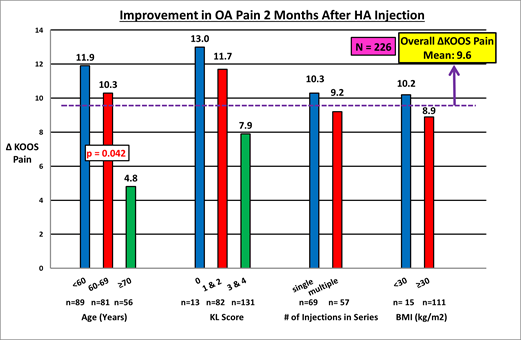Session Information
Session Type: ACR Poster Session A
Session Time: 9:00AM-11:00AM
Background/Purpose: Hyaluronic acid (HA) viscosupplementation is widely used in patients with knee osteoarthritis (KOA), but variable reported outcomes have impacted its incorporation into treatment algorithms. The current study examined clinical predictors of response to HA injections.
Methods: Patients receiving HA injections during routine visits were enrolled if they had KOA pain for ≥1 month and VAS pain ≥30. Baseline assessments included BMI, the Knee Injury and Osteoarthritis Outcome Score (KOOS) questionnaire, and standing knee xrays scored for Kellgren-Lawrence grade. The use of single vs multi-week HA products, anatomic injection approach, and use of ultrasound guidance were additional variables. Patients completed the KOOS at 2 months post-treatment to evaluate improvement from baseline.
Results: We screened 384 and enrolled 287 patients (65.5% female, age 62 years ±11, 28-88; BMI 31.0 kg/m2±6.7, 18-54) with a baseline mean KOOS pain score (0 to 100) of 51.5 ±17.4, We obtained 2 month follow-up from 226 patients, with a mean KOOS pain improvement of 9.6 (Fig. 1) and similar results with other KOOS subscores. After 2 months, younger patients reported significantly better ΔKOOS pain improvement. Those <60 benefitted more than the 60-69 age group, with the mildest response from those 70 and older (11.9±16.7 vs 10.3±17.8 vs 4.8±14.4, p=0.042). A similar trend followed for the % of patients who showed any improvement in these subgroups (73.0%, 65.4%, 60.7%). Patients with less severe radiographic disease trended towards more improvement, with KL0 vs KL1/2 vs KL3/4 ΔKOOS pain scores of 13.0±17.4, 11.7±17.7 and 7.9±16.0, p=0.205 and response rates of 76.9%, 71.9%, and 66.4%. Those receiving a single-dose injection had similar ΔKOOS pain results than the traditionally-used multi-week versions (10.3±15.0 vs 9.2±17.5, p=0.674). This single-dose group displayed a higher % of any improvement (76.8% vs 63.1%). Obese (BMI>30) and non-obese patients responded similarly with ΔKOOS pain averages of 10.2 and 8.9 and response rates of 68.7% and 65.8%. Further breakdown into smaller BMI subgroups was similarly unrevealing, as was a linear regression of BMI vs ΔKOOS Pain (R=0.178, p= 0.674). In addition, we found no significant difference in outcome from various anatomic needle approaches (medial, lateral, flexed knee) or from the use of ultrasound guidance.
Conclusion: Younger KOA patients responded better 2 months following a course of HA viscosupplementation, and there was a trend towards more improvement in patients with less severe radiographic disease. Obesity, anatomic approach and ultrasound guidance did not appear to impact response. Single-injection formulations provided as much improvement as multi-injection products by KOOS scores – with less time and expense. These results could tailor future algorithms for more appropriate and cost-effective use of HA in KOA management.
To cite this abstract in AMA style:
Mukherjee T, Bomfim F, Wilder E, Browne L, Aharon S, Toth K, Strauss E, Samuels J. Viscosupplemenation Efficacy in Knee Oa Is Similar in Single-Injection Vs. Multi-Week Formulations and Across OA Severity and BMI Subgroups, but Better in Younger Patients [abstract]. Arthritis Rheumatol. 2016; 68 (suppl 10). https://acrabstracts.org/abstract/viscosupplemenation-efficacy-in-knee-oa-is-similar-in-single-injection-vs-multi-week-formulations-and-across-oa-severity-and-bmi-subgroups-but-better-in-younger-patients/. Accessed .« Back to 2016 ACR/ARHP Annual Meeting
ACR Meeting Abstracts - https://acrabstracts.org/abstract/viscosupplemenation-efficacy-in-knee-oa-is-similar-in-single-injection-vs-multi-week-formulations-and-across-oa-severity-and-bmi-subgroups-but-better-in-younger-patients/

